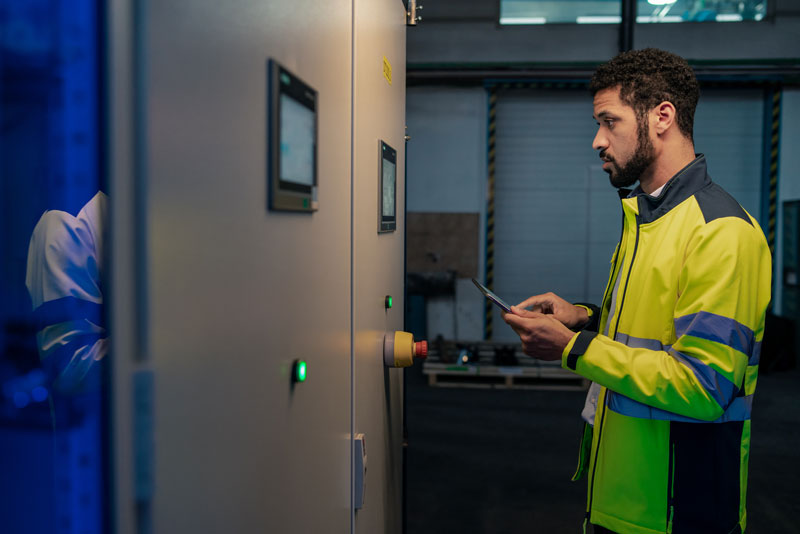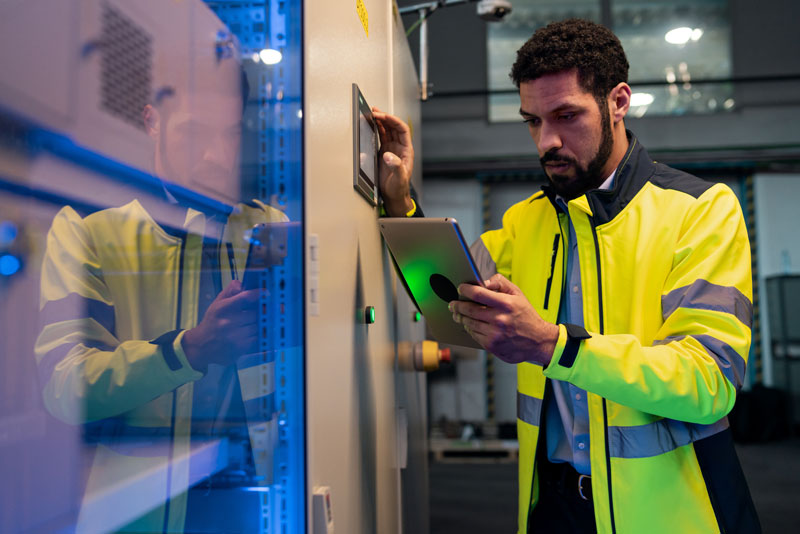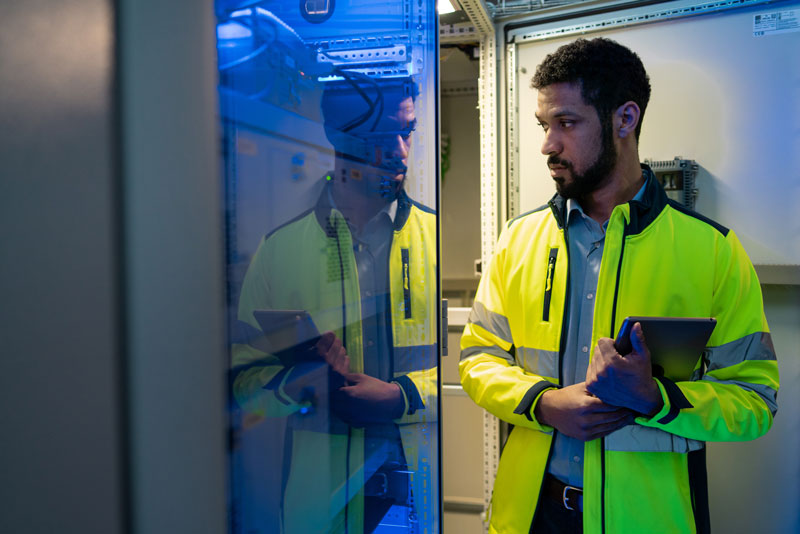Data collection is the foundation of a reliable and effective decision making process. In the manufacturing industry, the ultimate goal of collecting data is to gather information and insights about operational effectiveness. In simple words, you can’t make any decision about your operations without gathering machine data and production data. This can prevent avoidable production losses and make room for impactful improvements.
This is precisely where machine monitoring systems can help analyze production data and make informed decisions. Here, we explain the purpose and benefits of using a machine monitoring system and how it improves your manufacturing process from start to finish.
What is a machine monitoring system?
Essentially, a machine monitoring system is a solution that provides and delivers machine monitoring functions.
To gain a better understanding, let’s define what machine monitoring is. Machine monitoring is the process of gathering industrial machine data, storing and displaying them. It is a fully automated process that can combine sensor-captured data and operative inputs at shop floor level into real time data and immediate insights.
The machine monitoring system, on the other hand, encompasses both the machine monitoring software and the hardware tools required to process the raw machine data. This includes tools such as sensors, touchscreen dashboards mounted on machines, and powerful analytics software.
Theory: How Does Machine Monitoring Systems Work?
At the core of machine monitoring, the machine monitoring software solution is designed to enable real time monitoring through data collecting, analyzing, and displaying. The real time data captured by the sensors and interfaces attached to the machines is passed for further analysis to the software tool.
In general, the software acts as an enabler, providing real time visibility into machine condition monitoring, comparison vs historical data, overall tool lifecycle based on statistical analysis, and production data. Equipped with the necessary information, your team can make better decisions, such as planning preventive maintenance to prevent machine failure or identifying time consuming operations.
Big Data Analytics with Machine Monitoring Software
The software can provide data collection, data organizing, and statistical analysis. Machine monitoring helps with real time machine data, providing immediate insights, and overall production and OEE improvements.
More often than not, gaining access and visibility to real time data is challenging. In conventional operations, manufacturers continue to collect data manually on the shop floor before entering it into production management systems. This practice is time intensive and can lead to inaccurate production information and non-actionable data.
Additionally, the slow analysis that follows manual data collection and entry delays future decision making and immediate action.
Smart manufacturing systems fitted with a machine monitoring solution can solve all issues related to conventional operations monitoring:
- Real time machine monitoring for accurate and relevant data
- Large volumes of data can be collected from the different machines on the shop floor
- Immediate data analysis and insights
Paired with machine learning and AI, big analytics can enable predictive maintenance and even real time notifications when an anomaly is detected.

Machine Monitoring System and Its Benefits
The typical system for monitoring machines consists of 4 core elements that work together to deliver valuable insights.
Firstly, the shop floor requires machines to be fitted with tools that can collect data, such as sensors and edge devices. For analog machines designed and installed before the digital era, it can be necessary to attach them to a gateway to aggregate data before connecting to the Internet. Smart machines, on the other hand, are already designed for an IoT environment.
An analytics solution is required to combine data into a meaningful display. This can include historical analytics of a specific machine within the production, machine condition monitoring, cycle time, parts produced, product quality score, and more.
Manufacturing software is essential to making machine data meaningful and intelligible.
Finally, another crucial aspect of machine monitoring solutions is the ability to automatically create work orders to reduce the risks of human errors.
Data Collection For Immediate Insights
Using machine monitoring enables manufacturers to strategically measure overall equipment effectiveness and productivity through the real time production data. Sensor data can help track essential manufacturing and production metrics related to:
- Machine life cycle
- Product quality
- OEE
- Production times and machine downtime
- Cycle time
- Etc.
Accurate Data For Predictive Maintenance
Machine monitoring eliminates bias and errors that may occur with manual data capture and entry. Additionally, since smart machines can capture data in real time, the team receives real time insights, which enables them to take immediate action.
Through historical analytics, machine monitoring solutions can also preempt faults and issues, reducing production losses linked to unplanned downtime. Machine downtimes are one of the root causes of a slow cycle time and a drop in equipment effectiveness, performance, and productivity. Access to reliable data in real time can feed predictive maintenance, which increases cycle time and the number of parts produced.
Organizing Data For Accurate Understanding
Through further analysis, such as production statistics, the team can also gain deeper insights into aspects of the production that could be costing time or money. Monitoring production can highlight real time habits that are harmful to your processes and bottom-line profitability.
For example, identifying production bottlenecks ahead can prevent aggravated losses by organizing better production schedules.
Additionally, machine data can also be useful when it comes to improving production time and quality through informed tool path monitoring and feed rate recommendations.

Why Industrial IoT Brings Machine Monitoring Further
Industrial IoT brings machine monitoring to the next level through the use of smart machines equipped with advanced and accurate sensors. Paired with a user-friendly interface and gateway connectivity, machine monitoring solutions deliver a full view of the production performance.
Additionally, solutions utilize both real time data and historical data to support actionable, immediate actions and long-term improvement decisions.
Collect Data At Assembly Lines
An interface at machine-level enables operators to provide human context to the data captured by the sensors. They can reject parts, stop jobs or even provide additional information about equipment downtime issues, enhancing production data.
IoT Devices Can Send Real Time Machine Status
Malfunctions don’t go unnoticed as the system can send notifications, such as text messages, to inform operators and prompt rapid resolutions.
Shop Floor Real Time Dashboards
Real time dashboards can showcase all the required information to help workers make the best process decision. From machine performance metrics to other real-time values, these can support effective shop floor management.
Resource Utilization Reporting
When is it time to purchase new equipment? Waiting too long could lead to machine downtimes. Purchasing too early could incur unnecessary costs.
Machine monitoring can view real-time equipment status and monitor utilization over time to help determine the best moment for equipment renewal.
Eliminate Waste In Shop Floor Setup Time
Changing jobs can lead to production losses, costing valuable setup time each time operators have a changeover.
Machine monitoring can provide an accurate setup time estimate, making production reporting and improvements more accurate.

The Different Machine Monitoring Software Applications
Machine Monitoring Solution With Industrial IoT
The introduction of smart machines on the shop floor makes it easier to monitor the manufacturing process and identify potential issues.
Machine Health
The condition of the equipment is essential to maintaining high quality and performance throughout the production. This set of data monitors machine-specific parameters such as vibrations, temperature, pressure, and maintenance.
Precise Operations Machines
Precise operations refer to programmed controls used in smart manufacturing systems to increase machine accuracy. This studies machine operability and gathers information regarding the tool lifecycle, tool path, feed rate, etc.
Machine Availability
This set of data monitors machine downtime and the underlying cause for the shutdown.
Production Data & Production Flow
Production flow is the part of the machine monitoring system that identifies precisely where the product is. This tracks each movement for speedy delivery.
Resource Consumption
Manufacturing processes use consumption data to minimize wastage and track the effective utilization of resources, such as coolant, fuel, electricity, etc.
Machine Data Collection For Manufacturing Process in Different Industries
Machine monitoring systems are applicable to a broad range of processes in the manufacturing industry. Hence, the tools make it easier to consistently analyze production metrics and performance, regardless of your industry processes.
The ultimate goal with machine monitoring remains the same: Track machine data to make positive improvements.
Data Driven Insights For OEE Software
OEE machine monitoring solutions require only a small amount of information to deliver a full OEE overview of relevant metrics:
- Ideal cycle time
- Sensor monitoring Cycle
- Sensor monitoring Good Count
In conclusion, a machine monitoring system is central to collecting insights about your production and your equipment. Using machine data monitoring can non only support the decision making process in the manufacturing industry, but it can also drive productivity, effectiveness, and enhanced performance.
At OEEsystems, we stand for operational excellence with solutions that empower the manufacturing industry to create continual improvement. If you want to find out more about machine monitoring and how it can affect your OEE metrics, feel free to reach out to our team.
